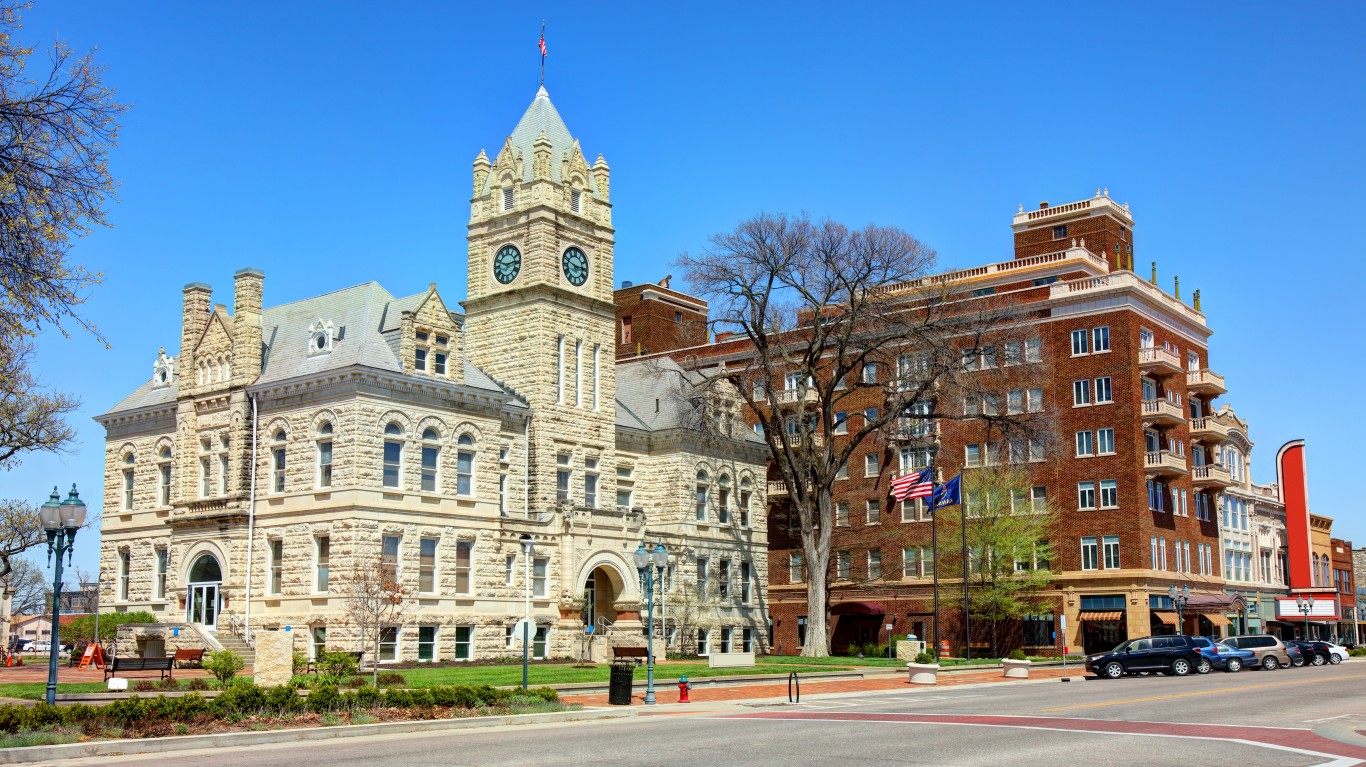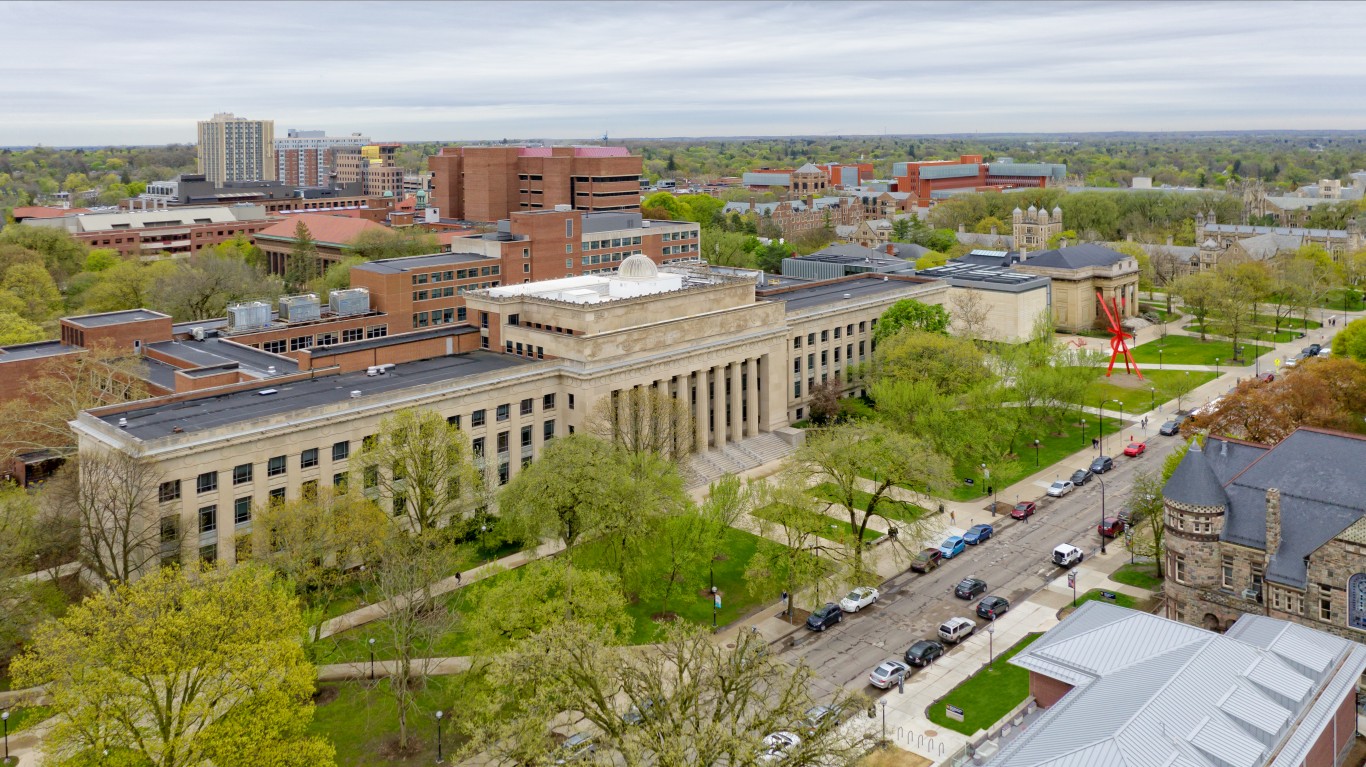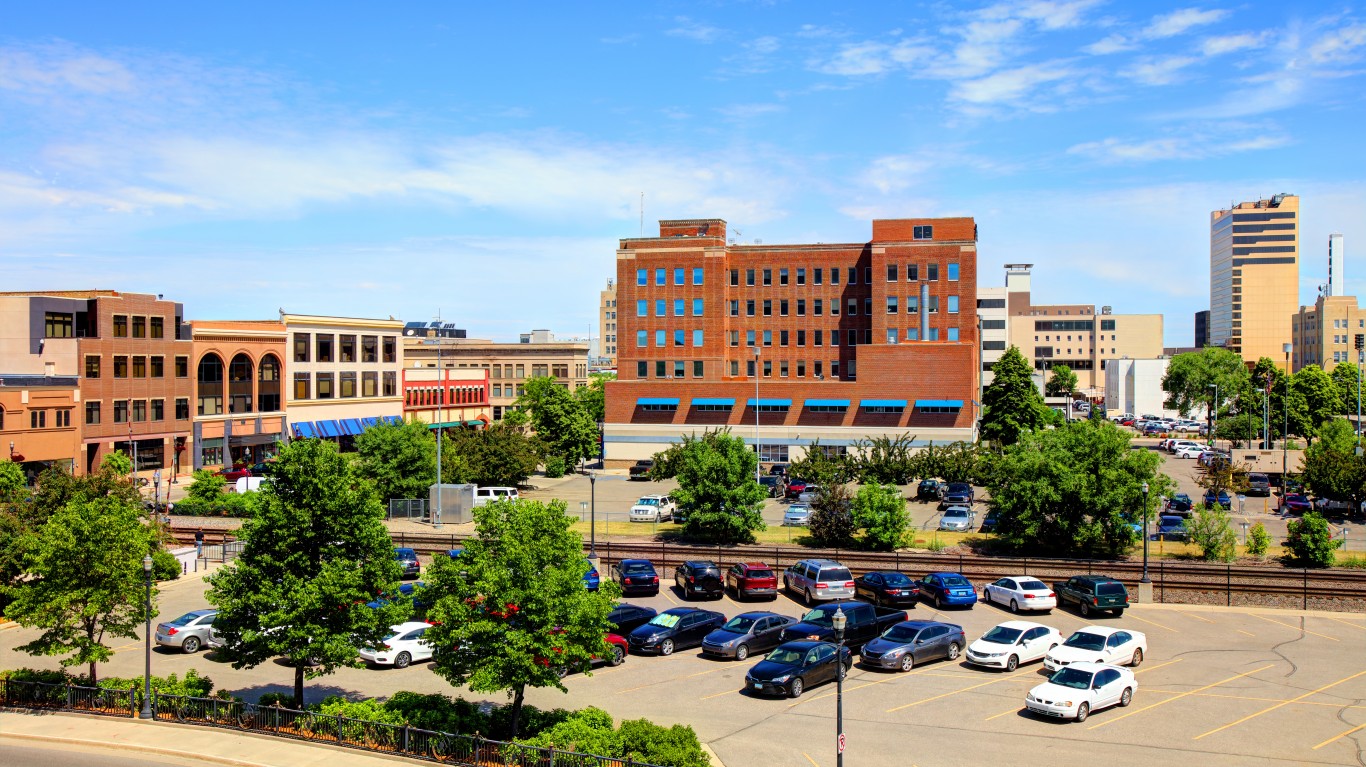
Though there is no way to guarantee a long and healthy life, exercising, making regular doctor visits, eating a healthy diet, and abstaining from bad habits like smoking, drug use, and excessive drinking can certainly improve the odds. While this should not come as news to anyone, there are parts of the country where such behaviors are far more common than in others and many of these places also have better health outcomes. .
24/7 Tempo created a weighted index of 35 measures of health outcomes and health factors, including behaviors and access to care, and ranked 381 U.S. metropolitan areas based on the index to identify the healthiest city in every state. Index measures include smoking rates, adult obesity rates, premature death rates, shares of adults who exercise regularly, and health insurance coverage. All health data came from County Health Rankings & Roadmaps, a joint program of the Robert Wood Johnson Foundation and the University of Wisconsin Population Health Institute.
Because the index is based largely on measures of behaviors and health outcomes, residents of the cities on this list tend to have healthy habits and a reduced likelihood of poor health. However, the cities on this list are also similar in some other, perhaps less obvious, ways.
For one, the cities on this list tend to be relatively wealthy places — at least compared to other cities in their respective states. In the vast majority of the healthiest cities by state, the median household income is higher than the median household incomes across the state as a whole. This is likely not a coincidence. Higher-income Americans tend to have better access to health care and can afford healthier options related to diet and lifestyle. Here is the richest city in each state.
It is important to note that appearing on this list does not necessarily mean a particular city is healthy compared to the country as a whole. Many states have relatively large populations that engage in unhealthy behaviors that tend to increase the likelihood of premature death. Even in the healthiest cities in many of these states, adults are less likely to live long, healthy lives than the typical American. Here is a list of the healthiest states in America.
Click here to see the healthiest city in every state
Click here to read our methodology

Alabama: Daphne-Fairhope-Foley
> Adult obesity rate: 31.0% (state: 35.5%)
> Adult smoking rate: 17.5% (state: 20.9%)
> Pct. of adults who exercise: 73.5% (state: 70.2%)
> Residents with health insurance: 88.7% (state: 89.0%)
> Median household income: $56,439 (state: $51,734)
The Daphne metro area ranks as the healthiest city in Alabama. However, city residents are less healthy than the average American by several measures. Some 26.5% of adults in Daphne are physically inactive, for example, a lower inactivity rate than the 29.2% rate statewide yet higher than the 23.0% rate nationwide. Similarly, 31.0% of adults in Daphne are obese, below the state obesity rate of 35.5% yet slightly higher than the national rate of 29.0%.
Obesity is a risk factor for a number of potentially deadly diseases and conditions. In Daphne, 353 in every 100,000 residents die before the age of 75, the lowest premature death rate of any city in Alabama and far below the state premature death rate of 475 per 100,000. Nationwide, some 340 in every 100,000 Americans die before the age of 75 annually.
[in-text-ad]

Alaska: Fairbanks
> Adult obesity rate: 30.0% (state: 32.5%)
> Adult smoking rate: 15.9% (state: 21.0%)
> Pct. of adults who exercise: 81.8% (state: 80.0%)
> Residents with health insurance: 86.8% (state: 85.2%)
> Median household income: $72,065 (state: $75,463)
Fairbanks is one of just two metro areas in Alaska and tends to be the healthier of the two — the other is Anchorage — in several key health outcome measures.
Adult Fairbanks residents report an average of three physically unhealthy days a month, one of the lowest averages among all 381 metro areas in the country and less compared to adults in Anchorage, who report an average of 3.6 physically unhealthy days a month. The metro area also has one of the lowest shares of adults who report being in poor or fair health and one of the lower low birthweight rates among newborns of any U.S. metro area.

Arizona: Phoenix-Mesa-Scottsdale
> Adult obesity rate: 27.5% (state: 27.5%)
> Adult smoking rate: 13.9% (state: 15.6%)
> Pct. of adults who exercise: 78.9% (state: 78.2%)
> Residents with health insurance: 88.0% (state: 87.9%)
> Median household income: $67,896 (state: $62,055)
Phoenix-Mesa-Scottsdale ranks as the healthiest metro area in Arizona. Adult residents report an average of 3.6 physically unhealthy days a month, the lowest of all seven metro areas in the state, compared to a statewide average of 4.0 days a month. Additionally, just 13.9% of metro area adults smoke, well below the 15.6% smoking rate across Arizona.
Just 16.0% of metro area adults report being in fair or poor health, a smaller share than the 18.6% of adults across the state as a whole.

Arkansas: Fayetteville-Springdale-Rogers
> Adult obesity rate: 29.7% (state: 34.2%)
> Adult smoking rate: 18.0% (state: 22.3%)
> Pct. of adults who exercise: 75.4% (state: 68.4%)
> Residents with health insurance: 88.3% (state: 90.7%)
> Median household income: $61,674 (state: $48,952)
Based on a number of key health measures, all six metropolitan areas in Arkansas compare unfavorably to the nation as a whole. The Fayetteville metro area, however, compares favorably to the other five metro areas in several important measures of health considered in the index, and in a few it even compares favorably to the U.S. as a whole.
Notably, Fayetteville’s premature mortality rate of 348 deaths before age 75 per 100,000 residents is much lower than every other metro area in the state and slightly higher than the national rate of 340 per 100,000. In all the other Arkansas metro areas, premature mortality rates exceed 400 per 100,000. Additionally, the adult smoking rate in Fayetteville is 17.9%, the lowest among the state’s six metro areas and just over the national smoking rate of 17.0%.
[in-text-ad-2]

California: San Jose-Sunnyvale-Santa Clara
> Adult obesity rate: 20.0% (state: 23.6%)
> Adult smoking rate: 8.3% (state: 11.3%)
> Pct. of adults who exercise: 83.8% (state: 82.4%)
> Residents with health insurance: 94.8% (state: 91.8%)
> Median household income: $130,865 (state: $80,440)
San Jose is the healthiest metro area in California and one of the healthiest nationwide. Just 20.0% of metro area adults are obese, well below the 29.0% national obesity rate. Additionally, the metro area is one only two nationwide where adults report an average of fewer than three mentally unhealthy days per month and one of nine metro areas in the U.S. where adults report an average of fewer than three physically unhealthy days per month.
Remaining physically active can be critical to remaining healthy — both mentally and physically. In San Jose, only 16.2% of adults lead completely sedentary lives, a smaller share than the 17.6% state and 23.0% national physical inactivity rate.

Colorado: Boulder
> Adult obesity rate: 15.2% (state: 21.8%)
> Adult smoking rate: 11.3% (state: 14.6%)
> Pct. of adults who exercise: 90.5% (state: 84.5%)
> Residents with health insurance: 93.2% (state: 91.3%)
> Median household income: $88,535 (state: $77,127)
Boulder ranks not just as the healthiest metro areas in Colorado, but also one of the healthiest in the U.S. Just 11.6% of adults in the metro area report being in fair or poor health, one of the smallest shares of any metro area nationwide, and well below the U.S. share of 17.0%.
Boulder also has the second lowest obesity rate among U.S. metro areas, with just 15.2% of adults reporting a body mass index of 30 or greater. Obesity is one of the most direct indicators of good health behavior and outcomes.
[in-text-ad]

Connecticut: Bridgeport-Stamford-Norwalk
> Adult obesity rate: 21.3% (state: 25.8%)
> Adult smoking rate: 10.2% (state: 12.7%)
> Pct. of adults who exercise: 82.3% (state: 79.6%)
> Residents with health insurance: 91.1% (state: 93.7%)
> Median household income: $97,053 (state: $78,833)
Of the four metro areas in Connecticut, Bridgeport ranks as the healthiest. Adults report 2.6 physically unhealthy days a month, less than any other metro area in the U.S. and the only metro area in Connecticut where adults report an average of fewer than three physically unwell days per month. Adults in Bridgeport are also less likely to smoke or be obese and more likely to exercise regularly than those living in any other metro area in the state.
Those with higher income often have better access to health care and can afford a greater range of healthy options related to diet and lifestyle, and they often report higher health status as a result. In the Bridgeport-Stamford-Norwalk metro area, the typical household earns $97,053 a year, the highest median household income in Connecticut and the third highest in the U.S. It is well above the median household income of $78,833 across the state as a whole and the median of $65,712 across the country.

Delaware: Dover
> Adult obesity rate: 35.4% (state: 30.9%)
> Adult smoking rate: 16.8% (state: 17.0%)
> Pct. of adults who exercise: 68.8% (state: 72.3%)
> Residents with health insurance: 93.6% (state: 93.9%)
> Median household income: $58,001 (state: $70,176)
Dover is the only metro area in Delaware and ranks as the healthiest city by default. By several important measures, however, the capital city is less healthy than the state as a whole. For example, only about 68.8% of metro area adults exercise regularly compared to about 72.3% of adults across the state. Regular physical activity can help in maintaining a healhty weight, and in Dover, 35.4% of adults are obese, a higher obesity rate than the state rate of 30.9%.
One key measure by which Dover ranks more favorably than the state as a whole is smoking. The adult smoking rate in the city is 16.8%, slightly lower than the state and national smoking rate of 17.0%.

Florida: Naples-Immokalee-Marco Island
> Adult obesity rate: 21.3% (state: 26.6%)
> Adult smoking rate: 14.4% (state: 16.1%)
> Pct. of adults who exercise: 76.8% (state: 74.1%)
> Residents with health insurance: 77.2% (state: 84.0%)
> Median household income: $76,025 (state: $59,227)
Obesity is a risk factor for a number of serious and potentially fatal diseases and conditions, including diabetes, heart disease, and certain cancers. Just 21.3% of adults in the Naples metro area are obese, a far smaller share than the 26.6% of adults across Florida. The better than average obesity rate is likely due in part to healthier lifestyles. For example, 76.8% of adults in Naples exercise regularly compared to 74.1% of adults statewide. Similarly, adults in Naples are less likely to smoke than the typical adult in Florida.
The premature death rate in Naples is the lowest among the 22 metro areas in Florida. About 223 people per 100,000 residents die before the age of 75, compared to 339 premature deaths per 100,000 across the state as a whole.
[in-text-ad-2]

Georgia: Atlanta-Sandy Springs-Roswell
> Adult obesity rate: 30.4% (state: 32.0%)
> Adult smoking rate: 15.2% (state: 17.5%)
> Pct. of adults who exercise: 74.9% (state: 72.5%)
> Residents with health insurance: 85.1% (state: 84.5%)
> Median household income: $71,742 (state: $61,980)
Atlanta is not only the largest metro area in Georgia by far — it accounts for more than half of the state’s population — but also the healthiest. Metro area adults report the fewest average days of poor mental health per month. Atlanta also has the highest share of adult residents who exercise on a regular basis, at 74.9% compared to 72.5% of adults across the state. The area’s premature age-adjusted mortality rate of 324 deaths before age 75 for every 100,000 people is lower than the state premature mortality rate of 381 per 100,000.
Those with higher income often have better access to health care and can afford a healthier lifestyle. In the Atlanta-Sandy Springs-Roswell metro area, the typical household earns $71,742 a year, the highest median household income in Georgia and well above the median of $61,980 across the state as a whole.

Hawaii: Urban Honolulu
> Adult obesity rate: 23.4% (state: 23.7%)
> Adult smoking rate: 11.0% (state: 12.8%)
> Pct. of adults who exercise: 79.4% (state: 79.5%)
> Residents with health insurance: 95.9% (state: 95.4%)
> Median household income: $87,470 (state: $83,102)
Of the two metro areas in Hawaii — Kahului-Wailuku-Lahaina and Honolulu — Honolulu is the healthiest. Unlike the other metro area, adults in Honolulu are less likely to be obese and less likely to smoke than those in the Kahului-Wailuku-Lahaina metro area.
Americans with health insurance are more likely to make regular doctor visits for checkups and preventative care, and in Honolulu, only 4.1% of the population under 65 is uninsured, below both the 5.4% uninsured rate in Kahului-Wailuku-Lahaina and the state uninsured rate of 4.6%.
[in-text-ad]

Idaho: Boise City
> Adult obesity rate: 29.6% (state: 29.3%)
> Adult smoking rate: 12.8% (state: 14.3%)
> Pct. of adults who exercise: 81.5% (state: 79.2%)
> Residents with health insurance: 89.1% (state: 88.2%)
> Median household income: $66,466 (state: $60,999)
Boise City ranks as the healthiest of Idaho’s five metro areas. Metro area adults report the fewest days per month of poor physical health as well as the fewest average days per month of poor mental health in the state.
Those in the workforce who are steadily employed are less likely to deal with the stress associated with unemployment and are less likely to face poverty and financial uncertainty. Unemployed people are likely for a number of reasons to have worse health outcomes. Boise’s 2019 unemployment rate, however, was just 2.7%, one of the lowest among U.S. metro areas.

Illinois: Bloomington
> Adult obesity rate: 33.1% (state: 29.7%)
> Adult smoking rate: 15.0% (state: 15.5%)
> Pct. of adults who exercise: 76.6% (state: 77.7%)
> Residents with health insurance: 94.9% (state: 92.1%)
> Median household income: $68,784 (state: $69,187)
Just 14.7% of adults in Bloomington report being in fair or poor health, the second smallest share of the 10 metro areas in Illinois. The better outcome is due in part to healthier behaviors. For instance, adults in Bloomington are less likely to smoke than adults across the state as a whole. Additionally, with a 5.1% uninsured rate — the lowest of any metro area in the state — Bloomington residents are more likely to make regular visits to the doctor and receive preventive medical care.

Indiana: Columbus
> Adult obesity rate: 32.3% (state: 33.4%)
> Adult smoking rate: 18.6% (state: 21.8%)
> Pct. of adults who exercise: 74.7% (state: 73.3%)
> Residents with health insurance: 90.1% (state: 90.4%)
> Median household income: $72,555 (state: $57,603)
The Columbus metro area ranks as the healthiest of Indiana’s 12 metropolitan statistical areas, but compared to the country as a whole, the city ranks as average to slightly worse than average.
There are some exceptions, however. The metro area has a below average rate of newborns with low birth weight, a common indicator of poor regional health. Additionally, the metro area’s flu vaccination rate of 55.0% is significantly higher than both the state rate of 49.0% and the national flu vaccination rate of 46.0%. The premature mortality rate of 369 deaths before age 75 for every 100,000 people is far below the state rate of 401 per 100,000.
[in-text-ad-2]

Iowa: Ames
> Adult obesity rate: 26.2% (state: 33.2%)
> Adult smoking rate: 14.9% (state: 17.1%)
> Pct. of adults who exercise: 82.8% (state: 76.3%)
> Residents with health insurance: 94.7% (state: 94.5%)
> Median household income: $62,181 (state: $61,691)
Ames has the lowest premature death rate of any metro area in Iowa. This is likely due in part to healthier behaviors, as adults in Ames are more likely to exercise than adults across the state as a whole. The metro area is one of two in Iowa with an adult obesity rate lower than the national rate of 29.0%, and much lower than the state obesity rate of 33.2%.
The high exercise rate among adults in Ames is partially attributable to the presence of certain amenities in the city. For example, 93.1% of the metro area population has easy access to places for physical activity like parks and recreation centers, the largest share of any metro area in the state.

Kansas: Manhattan
> Adult obesity rate: 26.9% (state: 33.2%)
> Adult smoking rate: 14.6% (state: 17.4%)
> Pct. of adults who exercise: 81.2% (state: 75.2%)
> Residents with health insurance: 91.5% (state: 89.9%)
> Median household income: $59,010 (state: $62,087)
Manhattan ranks as the healthiest metro area in Kansas and one of the healthiest in the United States. Adults in the metro area tend to report relatively little time spent in a state of poor physical or mental health.
Children born with low birthweight — defined as under 2,500 grams, or about 5.5 pounds — are more likely to be susceptible to immediate and future health issues. A high rate of low birth weight in a given area can be an indicator of poor health among mothers in the area. Manhattan has one of the lowest rates of low birth weights of any U.S. metro area. Low birthweight rates are a potential risk factor for premature mortality, and Manhattan has the lowest premature death rate of any metro area in the state.
[in-text-ad]

Kentucky: Lexington-Fayette
> Adult obesity rate: 29.7% (state: 33.8%)
> Adult smoking rate: 19.4% (state: 24.6%)
> Pct. of adults who exercise: 77.1% (state: 71.4%)
> Residents with health insurance: 93.0% (state: 93.6%)
> Median household income: $60,492 (state: $52,295)
The obesity rate in the Lexington-Fayette metro area of 29.7% is slightly higher than the national rate of 29.0% but the lowest of the five metro areas in Kentucky. Physically active lifestyles can help in maintaining a healthy weight, and in Lexington, just 22.9% of adults get no exercise, the lowest physical inactivity rate of metro areas in the state.
People who are steadily employed are less likely to deal with the stress associated with unemployment and are less likely to face poverty and financial uncertainty. They are often more likely to have better health outcomes. Lexington-Fayette’s 2019 unemployment rate was just 3.4%, the lowest in the state.

Louisiana: Baton Rouge
> Adult obesity rate: 33.3% (state: 35.4%)
> Adult smoking rate: 19.2% (state: 23.1%)
> Pct. of adults who exercise: 71.7% (state: 70.8%)
> Residents with health insurance: 91.6% (state: 90.4%)
> Median household income: $60,746 (state: $51,073)
Louisiana’s nine metropolitan areas do not compare well to the U.S. as a whole in many key measures of health behavior or outcomes. But among these, Baton Rouge ranks as the best of the lot. While the capital city’s adult smoking rate of 19.2% is higher than the national rate of 17.0%, it is still the lowest in the state. The same goes for the city’s poverty rate of 15.0%, which, while higher than the national rate of 12.3% is still lower than any other metro area in the state. Areas with lower poverty rates tend to have better health outcomes.

Maine: Portland-South Portland
> Adult obesity rate: 26.5% (state: 29.9%)
> Adult smoking rate: 12.6% (state: 17.3%)
> Pct. of adults who exercise: 81.7% (state: 78.4%)
> Residents with health insurance: 91.1% (state: 89.8%)
> Median household income: $71,913 (state: $58,924)
Portland is the only metro area in Maine where adults report fewer than four mentally unhealthy days per month on average. This positive outcome may partially be due to a greater prevalence of healthy lifestyles. For example, just 26.5% of adults in the metro area are obese, the lowest obesity rate of Maine’s three metro areas and below the 29.9% state obesity rate. The coastal city also has the lowest smoking rate in the state and is home to a larger share of adults who exercise regularly than the state average.
[in-text-ad-2]

Maryland: California-Lexington Park
> Adult obesity rate: 36.4% (state: 31.0%)
> Adult smoking rate: 15.0% (state: 13.8%)
> Pct. of adults who exercise: 76.1% (state: 77.6%)
> Residents with health insurance: 94.8% (state: 93.0%)
> Median household income: $87,947 (state: $86,738)
California-Lexington Park has the lowest annual unemployment rate of any metro area in Maryland at just 3.3%. Additionally, just 13.0% of metro area adults report being in fair or poor health, the smallest share of the state’s five metro areas and well below the 14.9% share of adults across Maryland as a whole.
Americans with higher incomes are often able to have better access to health care as well as a greater range of healthy options related to diet and lifestyle. In the California-Lexington Park metro area, the typical household earns $87,947 a year, the most of any of the five metro areas in the state.

Massachusetts: Boston-Cambridge-Newton
> Adult obesity rate: 23.9% (state: 24.7%)
> Adult smoking rate: 12.2% (state: 13.7%)
> Pct. of adults who exercise: 79.8% (state: 78.7%)
> Residents with health insurance: 96.5% (state: 96.7%)
> Median household income: $94,430 (state: $85,843)
Boston-Cambridge-Newton is the healthiest metro area in one of the healthiest states. The area’s premature mortality rate of 264 deaths before age 75 per 100,000 people is far lower than the national premature mortality rate of 340 per 100,000 and by far the lowest in Massachusetts. Area adults also report the fewest number of mentally unhealthy days per month of metro areas in the state.
In self-reported assessments of general health, those who exercise regularly and exhibit other healthy behaviors are more likely to rank their health as good or excellent. In the Boston metro area, just 12.6% of adults report being in fair or poor health, the second smallest share in Massachusetts.
[in-text-ad]

Michigan: Ann Arbor
> Adult obesity rate: 24.5% (state: 32.0%)
> Adult smoking rate: 12.1% (state: 19.3%)
> Pct. of adults who exercise: 84.7% (state: 76.6%)
> Residents with health insurance: 95.4% (state: 93.9%)
> Median household income: $76,576 (state: $59,584)
Ann Arbor is not only the healthiest metro area in Michigan but it is also one of the healthiest in the entire country. Only 11.9% of adults in Ann Arbor are in fair or poor health, the smallest share of any of the state’s 14 metro areas and below the 17.4% of adults across the state as a whole or the 17.0% across the country reporting similar health. Additionally, Ann Arbor’s 24.5% obesity rate is the lowest in the state and well below the 32.0% state rate and the 29.0% national rate
Exercise can lead to a greater perception of one’s own well-being and help in maintaining a healthy weight. In Ann Arbor, about 84.7% of adults are regularly physically active, by far the largest share of the state’s metro areas and well above the share of 76.6% among adults in Michigan or the share of 77.0% among adults in the U.S.

Minnesota: Rochester
> Adult obesity rate: 29.6% (state: 27.9%)
> Adult smoking rate: 12.8% (state: 14.5%)
> Pct. of adults who exercise: 78.5% (state: 79.9%)
> Residents with health insurance: 95.3% (state: 94.9%)
> Median household income: $75,926 (state: $74,593)
Adults in Rochester report an average of just 2.7 physically unhealthy days per month, the smallest share of any metro area in Minnesota. Rochester residents are also less likely than residents statewide to engage in certain risky behaviors. For example, the rates of avoidable health outcomes like from sexually transmitted infections is lower in Rochester than they are across the state as a whole.
Only 10.2% of area adults report being in fair or poor health, the lowest share in the state and the second lowest among all U.S. metro areas. This may be partially due to healthy behaviors such as not smoking. Rochester’s adult smoking rate is 12.8%, lower than the state smoking rate of 14.5% or the national rate of 17.0%.

Mississippi: Jackson
> Adult obesity rate: 37.3% (state: 36.8%)
> Adult smoking rate: 17.6% (state: 22.2%)
> Pct. of adults who exercise: 69.8% (state: 68.1%)
> Residents with health insurance: 87.3% (state: 85.5%)
> Median household income: $52,426 (state: $45,792)
While Jackson is the healthiest metro area in Mississippi, city residents are still less healthy than the average American by several metrics. Some 17.6% of adults in Jackson smoke, for example, the smallest share in Mississippi but a higher smoking rate than the 17.0% national rate. Similarly, while Jackson’s 12.7% uninsured rate is slightly lower than the state rate of 14.5%, it is far higher than the national uninsured rate of 10.0%.
Tobacco use and obesity are the two leading causes of preventable death. In Jackson, 444 in every 100,000 residents die before the age of 75 annually, the lowest premature mortality rate in Mississippi yet far more than the national rate of 340 per 100,000.
[in-text-ad-2]

Missouri: Columbia
> Adult obesity rate: 26.0% (state: 32.2%)
> Adult smoking rate: 18.5% (state: 20.8%)
> Pct. of adults who exercise: 77.2% (state: 74.2%)
> Residents with health insurance: 89.9% (state: 89.1%)
> Median household income: $57,359 (state: $57,409)
People in Columbia, Missouri, are more likely to live long, healthy lives than those in any of the state’s eight other metro areas. The premature mortality rate of 289 deaths before age 75 for every 100,000 people in the metro area is well below the comparable statewide rate of 400 premature deaths per 100,000. Additionally, just 16.7% of adults in Columbia report being in fair or poor health, below the 18.0% of adults statewide.
The positive health outcomes are attributable in part to healthy behaviors. For example, adults in Columbia are more likely to exercise than adults across the state as a whole.

Montana: Missoula
> Adult obesity rate: 22.2% (state: 25.8%)
> Adult smoking rate: 17.0% (state: 17.2%)
> Pct. of adults who exercise: 83.3% (state: 78.4%)
> Residents with health insurance: 91.4% (state: 89.6%)
> Median household income: $57,347 (state: $57,153)
Obesity is one of the most direct indicators of poor health, and the condition is associated with many of the most common life-threatening conditions, including heart disease, cancer, diabetes, and hypertension. In Missoula, just 22.2% of adults are obese, compared to the state obesity rate of 25.8% and a national obesity rate of 29.0%.
One likely reason for the metro area’s relatively low obesity rate is the level of exercise the population reports. About 16.7% of Missoula residents report no leisure time physical activity, one of the lowest shares among all metro areas nationwide and well below the national inactivity rate of 23%. The metro area’s premature death rate is also lower than both the state and national averages.
[in-text-ad]

Nebraska: Lincoln
> Adult obesity rate: 28.8% (state: 32.2%)
> Adult smoking rate: 12.9% (state: 15.4%)
> Pct. of adults who exercise: 82.2% (state: 76.7%)
> Residents with health insurance: 91.7% (state: 90.4%)
> Median household income: $61,539 (state: $63,229)
Lincoln is the only metro area in Nebraska where the adult obesity rate, at 28.8%, is lower than the state’s adult obesity rate of 32.2%. Additionally, just 13.5% of adults in Lincoln report being in fair or poor health, the smallest share of any metro area in the state and below the 14.4% share of adults statewide.
Adults with a college education typically have a greater sense of control over their lives and are better equipped to make healthier choices. In Lincoln, 39.7% of adults have a bachelor’s degree, well above the state bachelor’s degree attainment rate of 33.2% and the national rate of 33.1%.

Nevada: Reno
> Adult obesity rate: 23.3% (state: 25.7%)
> Adult smoking rate: 15.2% (state: 17.6%)
> Pct. of adults who exercise: 81.5% (state: 76.9%)
> Residents with health insurance: 87.6% (state: 86.9%)
> Median household income: $72,132 (state: $63,276)
None of Nevada’s three metro areas — Reno, Las Vegas, and Carson City — are perfect models of good health behaviors or outcomes. Adults in all three, for example, report more days of poor physical health a month than the national average. However, Reno compares favorably to the other two in several important indicators.
Notably, Reno has by far the lowest adult obesity rate, at just 23.3%, compared to a national obesity rate of 29.0%. Reno’s adults are also the least likely in the state to have sedentary lifestyles. Just 18.5% of city adults report no leisure time physical activity, compared to 22.3% in Carson City and 23.9% in Las Vegas.

New Hampshire: Manchester-Nashua
> Adult obesity rate: 28.0% (state: 27.9%)
> Adult smoking rate: 13.5% (state: 15.7%)
> Pct. of adults who exercise: 77.5% (state: 78.7%)
> Residents with health insurance: 92.8% (state: 93.0%)
> Median household income: $83,626 (state: $77,933)
Manchester is the only metro area in New Hampshire and therefore ranks as the healthiest city by default. In fact, Manchester is slightly less healthy than the state as a whole in some measures of health outcomes. For example, the city’s premature mortality rate of 313 deaths before age 75 per 100,000 people is slightly higher than the comparable state rate of 308 per 100,000.
Despite a higher premature mortality rate, Manchester residents are more likely to exhibit certain healthier habits than the typical New Hampshire resident. Just 13.5% of metro area adults smoke and 20.2% drink excessively, compared to 15.7% and 20.7% of adults statewide, respectively.
[in-text-ad-2]

New Jersey: Trenton
> Adult obesity rate: 25.8% (state: 26.4%)
> Adult smoking rate: 13.6% (state: 13.7%)
> Pct. of adults who exercise: 75.7% (state: 74.0%)
> Residents with health insurance: 90.3% (state: 91.0%)
> Median household income: $79,492 (state: $85,751)
Those who have health insurance are more likely to receive adequate and timely medical care than those without it. In Trenton, just 9.7% of residents under age 65 do not have health insurance coverage, slightly below the national share of 10.0%.
Perhaps the most telling measure of positive health outcomes in Trenton is the metro area’s premature mortality rate. There are 302 deaths before age 75 out of every 100,000 metro area residents, by far the lowest in New Jersey. Of the three remaining metro areas in the state, the next lowest premature mortality rate is Ocean City’s at 402 per 100,000.

New Mexico: Santa Fe
> Adult obesity rate: 14.4% (state: 26.6%)
> Adult smoking rate: 13.7% (state: 17.5%)
> Pct. of adults who exercise: 87.9% (state: 80.3%)
> Residents with health insurance: 86.7% (state: 89.0%)
> Median household income: $61,298 (state: $51,945)
Sante Fe is the only metro area in New Mexico where adults report fewer than four physically unhealthy days per month. Sante Fe’s obesity rate of just 14.4% is also the lowest in both the state and the entire country. Across New Mexico, 26.6% of adults are obese, and nationwide, 29.0% of Americans are.
Wealthier individuals tend to have better access to health care and can better afford a range of healthy options related to diet and lifestyle. In Santa Fe, incomes tend to be higher than the average statewide. The typical metro area household earns $61,298 a year, about $9,000 more than the median household income of $51,945 across New Mexico.
[in-text-ad]

New York: Ithaca
> Adult obesity rate: 22.7% (state: 25.5%)
> Adult smoking rate: 14.1% (state: 14.1%)
> Pct. of adults who exercise: 84.3% (state: 75.3%)
> Residents with health insurance: 94.7% (state: 93.4%)
> Median household income: $58,626 (state: $72,108)
A high rate of low birth weights among newborns is often indicative of relatively poor health and nutrition of the mothers in that community. In Ithaca, just 6.8% of newborns are born under 2,500 grams (about 5.5 pounds), nearly the lowest share of low birthweight of New York’s 12 metro areas.
In Ithaca, which is home to Ithaca College and Cornell University, 56.9% of adults have a bachelor’s degree, the largest share in the state and the third largest share of U.S. metro areas. Adults with higher educational attainment are more likely to lead healthier lives.

North Carolina: Raleigh
> Adult obesity rate: 28.2% (state: 31.4%)
> Adult smoking rate: 13.3% (state: 17.2%)
> Pct. of adults who exercise: 81.1% (state: 75.7%)
> Residents with health insurance: 89.2% (state: 87.4%)
> Median household income: $80,096 (state: $57,341)
Wealthier Americans tend to report better health outcomes, as they often have better access to health care and can better afford a range of healthy diet and lifestyle options. In Raleigh, the typical household earns $80,096 a year, by far the most of any of North Carolina’s 15 metro areas and well above the statewide median household income of $57,341.
Only 18.9% of adults in Raleigh get no exercise beyond getting up and going to work, the lowest inactivity rate in the state and well below the rate of 24.3% across North Carolina. Regular physical activity can help in maintaining a healthy weight, and in Raleigh, 28.2% of adults are obese, well below the state obesity rate of 31.4%.

North Dakota: Fargo
> Adult obesity rate: 30.5% (state: 32.7%)
> Adult smoking rate: 16.0% (state: 18.3%)
> Pct. of adults who exercise: 80.6% (state: 76.1%)
> Residents with health insurance: 93.5% (state: 91.4%)
> Median household income: $62,820 (state: $64,577)
Based on several major measures of health outcomes, the residents of North Dakota’s three metropolitan areas — Fargo, Bismarck, and Grand Fork — are among the healthiest in the country. Fargo, however, ranks the healthiest of the three. Adults in the metro area report nearly the lowest average number of poor mental health days and poor physical health days per month of any U.S. metro area.
Unemployed Americans are more likely to have unhealthy lifestyles and poor health outcomes. In Fargo, the 2.3% annual unemployment rate in 2019 was the lowest in the state and well below the 3.7% national rate.
[in-text-ad-2]

Ohio: Columbus
> Adult obesity rate: 31.0% (state: 32.3%)
> Adult smoking rate: 19.1% (state: 21.1%)
> Pct. of adults who exercise: 76.2% (state: 73.6%)
> Residents with health insurance: 92.7% (state: 92.9%)
> Median household income: $67,207 (state: $58,642)
In Columbus, just 15.9% of adults report being in fair or poor health, the smallest share of any of Ohio ‘s 11 metro areas and well below the 18.0% share of adults reporting subpar health across the state as a whole.
Ohio is one of the states hit hardest by the opioid epidemic, and some metro areas in the state report among the highest drug overdose death rates in the country. In Columbus, however, there are 73 accidental deaths — which include drug overdoses — for every 100,000 people per year, nearly the lowest of any metro area in the state and well below the rate of 87 per 100,000 across Ohio.

Oklahoma: Oklahoma City
> Adult obesity rate: 32.7% (state: 33.7%)
> Adult smoking rate: 16.7% (state: 20.1%)
> Pct. of adults who exercise: 73.2% (state: 70.7%)
> Residents with health insurance: 85.0% (state: 83.5%)
> Median household income: $60,605 (state: $54,449)
All four of Oklahoma’s metropolitan areas have higher premature mortality rates — one of the clearest indicators of the overall health of a population — than the majority of U.S. metro areas. But of them, Oklahoma City has the lowest, with 411 deaths before the age of 75 per 100,000 people, compared to 458 deaths per 100,000 statewide.
Smoking is the leading cause of preventable death in the United States, and among Oklahoma’s four metro areas, the capital city has the lowest adult smoking rate, at 16.7%, compared to a smoking rate of 20.1% statewide.
[in-text-ad]

Oregon: Corvallis
> Adult obesity rate: 24.9% (state: 28.8%)
> Adult smoking rate: 13.3% (state: 16.1%)
> Pct. of adults who exercise: 86.8% (state: 82.8%)
> Residents with health insurance: 93.2% (state: 91.8%)
> Median household income: $70,835 (state: $67,058)
Corvallis is the healthiest metro area in Oregon and one of the healthiest in the United States. While no part of the country has been spared from the opioid epidemic, Corvallis has not been as hard as other metro areas in the state. There are 54 injury deaths — which include drug overdoses — in Corvallis for every 100,000 people annually, the lowest rate of any metro area in the state and well below the injury death rate of 74 per 100,000 across Oregon as a whole.
Adults in Corvallis are also more likely to exercise regularly than those in nearly every other metro area in the country. Just 13.2% of adults in the city lead completely sedentary lives, well below the physical inactivity rates of 17.2% statewide and 23.0% nationwide.

Pennsylvania: State College
> Adult obesity rate: 25.2% (state: 30.3%)
> Adult smoking rate: 17.0% (state: 18.7%)
> Pct. of adults who exercise: 81.9% (state: 76.9%)
> Residents with health insurance: 93.3% (state: 93.4%)
> Median household income: $60,706 (state: $63,463)
Residents of State College, Pennsylvania, are more likely to live long, healthy lives than those in any other metro area in the state. The premature mortality rate of 208 deaths before age 75 for every 100,000 people is lower than in every other metro area in Pennsylvania and lower than the state rate of 359 per 100,000.
The lower premature mortality rate in the area is due in part to healthier lifestyles. For example, about 82% of metro area adults get regular exercise, the largest share of the 18 metro areas in the state and well above the 77% of adults statewide. Regular exercise can help in maintaining a healthy weight, and in State College, just 25.2% of adults are obese, the smallest share in the state and well below the 30.3% state obesity rate.

Rhode Island: Providence-Warwick
> Adult obesity rate: 28.5% (state: 28.1%)
> Adult smoking rate: 14.3% (state: 14.9%)
> Pct. of adults who exercise: 74.8% (state: 75.6%)
> Residents with health insurance: 95.2% (state: 94.6%)
> Median household income: $70,967 (state: $71,169)
The Providence-Warwick metro area encompasses most of Rhode Island as well as Bristol County in Massachusetts. As the only metro area in Rhode Island, Providence ranks as the healthiest metro area in the state by default, and matches the state as a whole in most measures of health behaviors and outcomes.
For example, 28.5% of adults in Providence are obese compared to 28.1% of adults across the state as a whole. Similarly, 15.1% of adults in Providence report being in fair or poor health, a slightly smaller share than the 16.4% of adults across all of Rhode Island who do.
[in-text-ad-2]

South Carolina: Hilton Head Island-Bluffton-Beaufort
> Adult obesity rate: 26.2% (state: 32.9%)
> Adult smoking rate: 13.8% (state: 18.8%)
> Pct. of adults who exercise: 81.4% (state: 74.1%)
> Residents with health insurance: 83.9% (state: 86.9%)
> Median household income: $71,252 (state: $56,227)
While South Carolina is one of the least healthy states, the Hilton Head Island metro area is one of the healthiest cities nationwide. Just 13.8% of adults in Hilton Head smoke, the lowest smoking rate of any city in the state and far lower than both the 18.8% state and 17.0% national smoking rates. Additionally, just 26.2% of adults are obese, compared to the obesity rate of 32.9% statewide and 29.0% nationwide.
Tobacco use and obesity are the two leading causes of preventable death in the United States. In the Hilton Head Island metro area, 274 in every 100,000 residents die before the age of 75 — far lower than the state premature mortality rate of 413 per 100,000 and the least of any metro area in South Carolina.

South Dakota: Sioux Falls
> Adult obesity rate: 32.2% (state: 31.8%)
> Adult smoking rate: 14.9% (state: 19.3%)
> Pct. of adults who exercise: 80.2% (state: 78.7%)
> Residents with health insurance: 91.8% (state: 89.2%)
> Median household income: $65,566 (state: $59,533)
Of the two metro areas in South Dakota — Sioux Falls and Rapid City — Sioux Falls is the healthiest. Unlike in Rapid City, adults in Sioux City report fewer than three physically unhealthy days and fewer than three mentally unhealthy days per month on average.
Americans with health insurance are more likely to make regular doctor visits, and in Sioux Falls, 8.2% of the population lacks health insurance compared to 11.4% of Rapid City residents.
[in-text-ad]

Tennessee: Nashville-Davidson–Murfreesboro–Franklin
> Adult obesity rate: 31.4% (state: 33.2%)
> Adult smoking rate: 18.5% (state: 22.6%)
> Pct. of adults who exercise: 75.5% (state: 72.8%)
> Residents with health insurance: 89.0% (state: 88.7%)
> Median household income: $70,262 (state: $56,071)
The typical household in the Nashville metro area earns $70,262 a year, approximately $14,000 more than the median household income across Tennessee as a whole and the most of any city in the state. People with higher incomes tend to have greater access to quality health care and have better health outcomes overall.
In Nashville, 17.0% of adults report being in fair or poor health, the smallest share in Tennessee and far below the 19.7% share of adults across the state. Some 384 in every 100,000 residents in Nashville die before the age of 75 annually, far less than the state premature mortality rate of 451 per 100,000 and the lowest of any city in the state.

Texas: Austin-Round Rock
> Adult obesity rate: 26.6% (state: 30.1%)
> Adult smoking rate: 12.9% (state: 15.7%)
> Pct. of adults who exercise: 81.8% (state: 75.6%)
> Residents with health insurance: 85.6% (state: 80.6%)
> Median household income: $80,954 (state: $64,034)
Of the 25 metro areas in Texas, Austin is by far the healthiest. Only 26.6% of adults in the metro area are obese, the smallest share of any city in the state and well below the 30.1% state obesity rate. Regular physical activity can help in maintaining a healthy weight, and in Austin, only 18.2% of adults do not exercise, well below the 24.4% inactivity rate across the state as a whole.
Wealthier individuals tend to have better access to health care and can afford a greater range of healthy options related to diet and lifestyle, and incomes tend to be higher than average in Austin. The typical metro area household earns $80,954 a year, well above the median household income of $64,034 across Texas.

Utah: Provo-Orem
> Adult obesity rate: 25.1% (state: 25.9%)
> Adult smoking rate: 6.0% (state: 8.9%)
> Pct. of adults who exercise: 84.1% (state: 81.9%)
> Residents with health insurance: 91.9% (state: 90.0%)
> Median household income: $79,152 (state: $75,780)
Provo-Orem has one of the lowest premature mortality rates in the United States. There are 254 deaths before age 75 for every 100,000 people annually in the metro area. Across the state, there are 289 premature deaths for every 100,000 people and 340 per 100,000 nationwide.
The low premature death rate is partially attributable to healthy habits. For example, Provo is one of only two metro areas in the United States where fewer than one in every 10 adults drink excessively. Additionally, just 6.0% of area adults smoke, the lowest smoking rate in the country and well below the 8.9% rate statewide, and 17.0% rate nationwide.
[in-text-ad-2]

Vermont: Burlington-South Burlington
> Adult obesity rate: 25.6% (state: 26.3%)
> Adult smoking rate: 12.8% (state: 15.8%)
> Pct. of adults who exercise: 82.8% (state: 80.9%)
> Residents with health insurance: 95.0% (state: 94.5%)
> Median household income: $74,909 (state: $63,001)
Burlington is the only metro area in Vermont, and as a result, it ranks as the healthiest city in the state by default. Still, by several measures, city residents are more likely to report healthier lifestyles and have better health outcomes than the average Vermont resident. For example, just 12.8% of adults in Burlington smoke, compared to the 15.8% state smoking rate. Adults in Burlington are also more likely to regularly exercise and less likely to be obese than the typical adult in the state.
Healthy behaviors can lead to healthy outcomes, and in Burlington, adult residents report an average of just 4.0 mentally unhealthy days per month, compared to an average of about 4.5 days across the state.

Virginia: Charlottesville
> Adult obesity rate: 27.4% (state: 29.8%)
> Adult smoking rate: 15.8% (state: 16.4%)
> Pct. of adults who exercise: 78.4% (state: 77.1%)
> Residents with health insurance: 88.9% (state: 89.8%)
> Median household income: $75,907 (state: $76,456)
Charlottesville ranks as the healthiest of Virginia’s nine metro areas, largely due to the prevalence of healthy behaviors among the city’s residents. For example, 78.4% of adults in Charlottesville exercise regularly, the largest share of metro areas in the state and more than the 77.1% of adults in the state who are physically active. Additionally, just 15.8% of metro area adults smoke, and 27.4% are obese, the smallest and second smallest share of any metro area in the state, respectively.
[in-text-ad]

Washington: Seattle-Tacoma-Bellevue
> Adult obesity rate: 26.1% (state: 27.8%)
> Adult smoking rate: 11.1% (state: 13.5%)
> Pct. of adults who exercise: 84.4% (state: 83.0%)
> Residents with health insurance: 93.6% (state: 92.9%)
> Median household income: $94,027 (state: $78,687)
Of the 11 metro areas in Washington state, Seattle is the healthiest. Just 12.8% of adults in the metro area report being in fair or poor health, below both the 15.6% state and 17.0% national shares. Adults in Seattle are also more likely to exercise and less likely to smoke or be obese than adults across the state as a whole.
Adults with a college education tend to have higher incomes and make healthier lifestyle choices than those without a college degree. In Seattle, 44.1% of adults have a bachelor’s degree, well above the state bachelor’s degree attainment rate of 37.0% and the national rate of 33.1%.

West Virginia: Morgantown
> Adult obesity rate: 31.3% (state: 36.7%)
> Adult smoking rate: 20.5% (state: 26.0%)
> Pct. of adults who exercise: 76.6% (state: 71.1%)
> Residents with health insurance: 92.6% (state: 92.5%)
> Median household income: $56,395 (state: $48,850)
While Morgantown is the healthiest city in West Virginia, metro area residents are less healthy than the average American by several measures. Some 20.5% of adults in Morgantown smoke, for example, the second smallest share of any city in the state yet higher than the 17.0% national smoking rate. Similarly, some 31.3% of adults in Morgantown are obese, the smallest share of any metro area in the state yet far above the 29.0% national obesity rate.
Tobacco use and obesity can increase the risk of certain serious diseases and conditions and raise the likelihood of premature death overall. In Morgantown, 339 in every 100,000 residents die before the age of 75 annually, less than the state premature mortality rate of 502 per 100,000 and in line with the national rate of 340 premature deaths per 100,000 Americans.

Wisconsin: Madison
> Adult obesity rate: 26.9% (state: 31.3%)
> Adult smoking rate: 12.9% (state: 16.0%)
> Pct. of adults who exercise: 84.7% (state: 79.2%)
> Residents with health insurance: 94.8% (state: 93.6%)
> Median household income: $75,545 (state: $64,168)
Just 12.9% of adults in Madison smoke and just 26.9% are obese, each less than the corresponding state rates of 16.0% and 31.3%. Tobacco use and obesity are two of the leading causes of preventable death. In Madison, 246 in every 100,000 residents die before age 75 annually — less than the state premature mortality rate of 308 per 100,000 and one of the lowest rates of any city nationwide.
Income is one of the primary determinants of health, and areas with lower poverty rates tend to have better health outcomes. In Madison, just 8.9% of residents live in poverty, far less than the state’s 10.4% poverty rate and one of the lowest poverty rates of metro areas in the state.
[in-text-ad-2]

Wyoming: Cheyenne
> Adult obesity rate: 30.0% (state: 28.9%)
> Adult smoking rate: 17.0% (state: 18.7%)
> Pct. of adults who exercise: 76.6% (state: 75.9%)
> Residents with health insurance: 88.6% (state: 85.8%)
> Median household income: $70,567 (state: $65,003)
Of the two metro areas in Wyoming — Cheyenne and Casper — Cheyenne ranks as the healthiest. Some 23.4% of adults in Cheyenne do not exercise regularly, a lower inactivity rate than the 25.0% in Casper and the 24.1% across Wyoming as a whole. Similarly, 30.0% of adults in Cheyenne are obese, less than the obesity rate of 31.8% in Casper, yet higher than the 28.9% obesity rate statewide.
Obesity and sedentary lifestyles can increase the risk of premature death. In Cheyenne, 348 in every 100,000 residents die before the age of 75, a lower premature mortality rate than in Casper of 367 per 100,000.
Methodology
To determine the healthiest city in every state, 24/7 Tempo created an index composed of 35 health outcomes and health factors with data from the 2020 County Health Rankings & Roadmaps, a joint program of the Robert Wood Johnson Foundation and the University of Wisconsin Population Health Institute. We calculated composite scores for outcomes and factors separately, then combined the two scores to form a single score that determined the metropolitan statistical area’s rank.
All data used in the index came from the CHR with the exception of 2019 annual unemployment rates for each MSA — these are the most recent annual figures available from the Bureau of Labor Statistics’ Local Area Unemployment Statistics program. For all other CHR measures, county-level data was aggregated to the MSA level using raw values provided at the county level, and measures without raw values by county were calculated using weighted averages based on population distribution within each MSA by county.
We also considered measures from the U.S. Census Bureau’s 2019 American Community Survey, including median household income and poverty and educational attainment rates. These measures were not included in the index.
Values selected for the index were standardized into Z-Scores, which assumes a mean of 0 and a standard deviation of 1. Z-scores were calculated for each index measure by MSA within each city’s respective state. If an MSA spans multiple states, then the city is indexed according to its primary state, as designated by the Census Bureau. Note that four states — Rhode Island, New Hampshire, Vermont, and Delaware — only have one MSA.
Health outcomes with the heaviest weights in the index include the age-adjusted premature mortality rate, the percentage of births with low birthweight, the percentage of adults reporting fair or poor health, and the age-adjusted average number of mentally and physically unhealthy days per month. The premature mortality rate is defined as the number of deaths under the age of 75 per 100,000 people. Unhealthy days are determined by the average number of days out of the month the adult population (18+) self-identifies as being unwell. This is used as an indicator of how chronic disabilities or illnesses (physical and mental) affect the members of a particular geography.
Health factors with the heaviest weights in the index include the smoking rate, the 2019 annual unemployment rate, injury mortality rate, and the child poverty rate. The injury mortality rates is the the number of deaths due to injury, whether intentional (for example suicide), or unintentional (drug overdose, car accidents, accidental suffocation, etc) per 100,000. Air quality is also considered in the health factors category and is determined by measuring the average daily density of particulate matter at 2.5 micrograms (or PM2.5 for short).
The remaining measures included in the index, and an explanation as to how these measures are useful in assessing the health of a given population, can be found at County Health Rankings & Roadmaps.
Travel Cards Are Getting Too Good To Ignore (sponsored)
Credit card companies are pulling out all the stops, with the issuers are offering insane travel rewards and perks.
We’re talking huge sign-up bonuses, points on every purchase, and benefits like lounge access, travel credits, and free hotel nights. For travelers, these rewards can add up to thousands of dollars in flights, upgrades, and luxury experiences every year.
It’s like getting paid to travel — and it’s available to qualified borrowers who know where to look.
We’ve rounded up some of the best travel credit cards on the market. Click here to see the list. Don’t miss these offers — they won’t be this good forever.
Thank you for reading! Have some feedback for us?
Contact the 24/7 Wall St. editorial team.
 24/7 Wall St.
24/7 Wall St. 24/7 Wall St.
24/7 Wall St. 24/7 Wall St.
24/7 Wall St. 24/7 Wall St.
24/7 Wall St.


